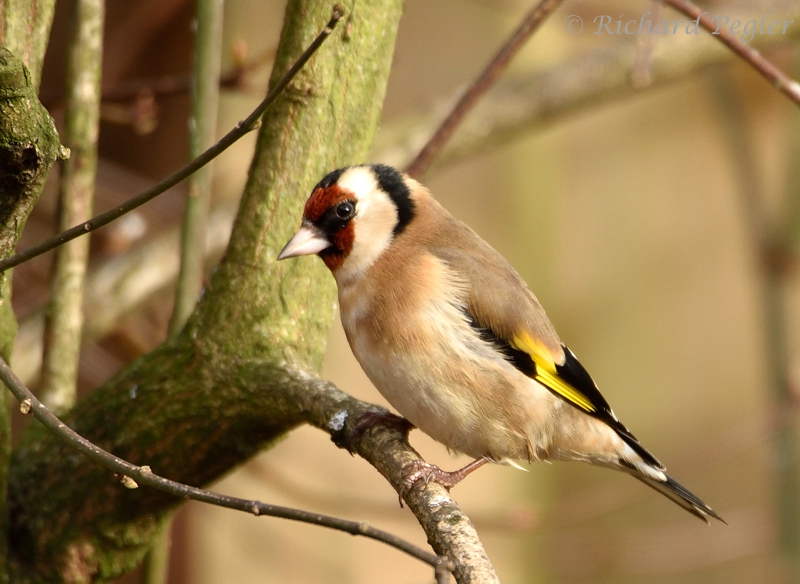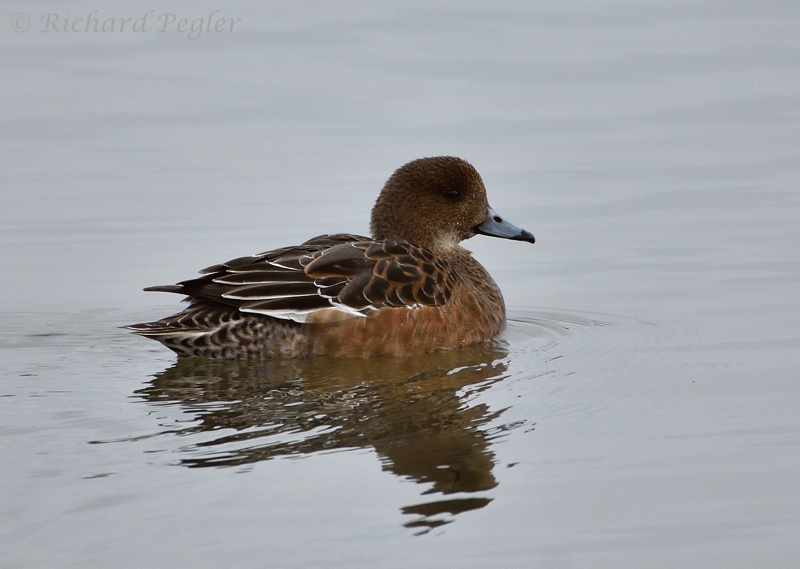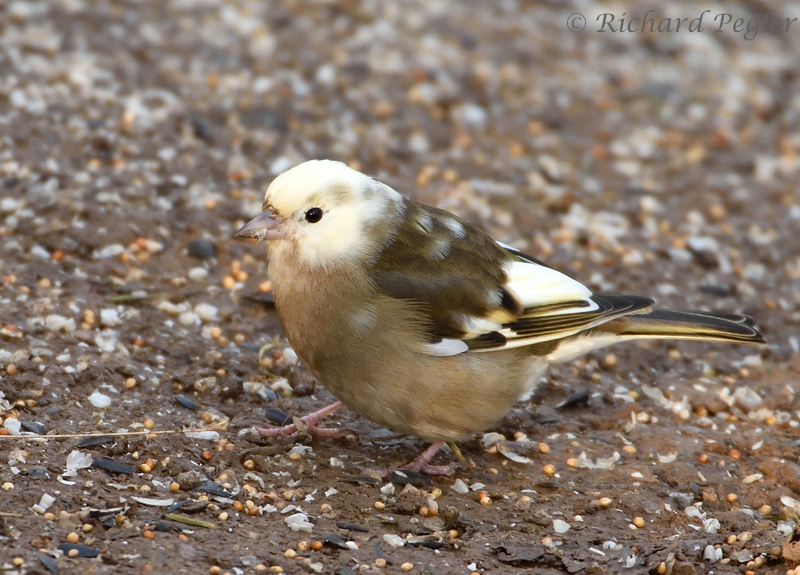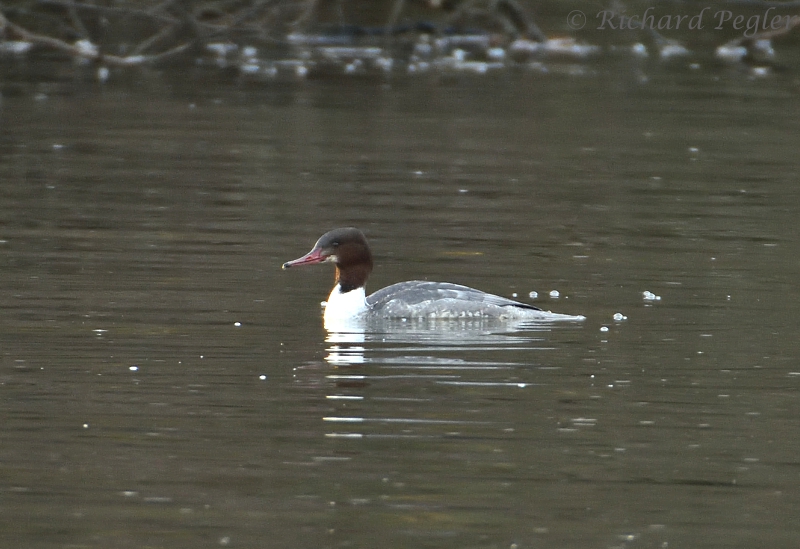I started the year with a resolve to get out more into the countryside in search of birds and other wildlife. However, I didn't reckon with avian visits to the garden getting more interesting, making it difficult for me to tear myself away from home. Thankfully, I have a vacation coming up for which I need to get myself into shape for much more walking than I am used to of late, and this helped get me back on track - to a degree!
Rather than give you a chronological account as usually do, I shall attempt to focus on subject matter. I wonder how this will turn out?!
Winter Garden Visitors
Brambling
I have struggled to get good photos of our winter visitors as they are usually either on feeders or hidden behind the twigs of the garden shrubs and trees. It did not help that the first half of January was largely dull and misty. I did resort to setting my hide up in the garden a couple of times, but did not achieve significantly better results. I don't usually like to post photos of birds on feeders but will do so below in order to show more detail on the bird
Most winters we get the occasional visit from Brambling although it is far from being a 'given'. A male Brambling started visiting the garden on a daily basis in December. On 3rd January a female Brambling appeared and, since then, both have visited regularly, although not as a pair. It does seem that this winter has been an exceptionally good one for local sightings of Brambling.
Brambling (Fringilla montifringilla) (female) - garden on 8th January, 2022
 |
| Brambling (Fringilla montifringilla) (male) - garden on 1st January, 2022 |
 |
| Brambling (Fringilla montifringilla) (male) - garden on 2nd January, 2022 |
 |
| Brambling (male) + Blackcap (Sylvia atricapilla) (female) - garden on 2nd January, 2022 |
 |
| Blackcap (Sylvia atricapilla) (female) - garden on 7th January, 2022 |
At one time, it was extremely unusual for a Pied Wagtail to visit our garden and if a wagtail visited at all it was usually the far less common Grey Wagtail that visited. However, over the past few years, visits by Pied Wagtail have increased to the extent that this winter, especially on cold days, a visit has been almost dependable.
NuthatchPied Wagtail (Motacilla alba yarrellii) (male) - garden on 15th January, 2021
Although Nuthatch can visit the garden at any time of year, it is usually in the winter that we get visits. We have been fortunate to have the occasional visit by one this winter.
 |
| Nuthatch (Sitta europaea) - garden on 2nd January, 2022 |
The UK's smallest bird has been a daily visitor so far this year, but is extremely difficult to photograph. I'm am confident, by its behaviour, that this is just one bird. It darts in, grabs a bill full from the fat balls and zooms back into cover. Sadly, this is the best shot that I managed during this period, from my study window.
Garden All Year Round-ersGoldcrest (Regulus regulus) - garden on 15th January, 2022
I decided to put a couple of common garden visitors in here - the first because it seems to be unusual behaviour (and is just plain cute!), and the second because they are such a spectacular small bird!
Grey Squirrel
Grey Squirrel is a daily visitor to the garden. When the nuts are ready, they rob our tree of the cob nuts. At other times they will feed on the peanuts and sunflower hearts that are put out for the birds. A few weeks back, I collected some crab-apples from a country lane as a possible source of food for winter thrushes. The only thrushes that took any interest at all were Blackbirds and their interest was short-lived. Lindsay and I were totally amazed when a Grey Squirrel decided to give one a try. The crab-apple was well and truly past its prime and may well have been alcoholic. We never observed it coming back for more!
GoldfinchGrey Squirrel (Scuirus carolinensis) - garden on 14th January, 2022
I cannot remember a day without a Goldfinch in the garden and this winter it has not been unusual to get days with around twenty of them present. Nevertheless, they are always a delight to observe. They are a feisty little bird, although no match for that female Blackcap!
 |
| Goldfinch (Carduelis carduelis) - garden on 7th January, 2022 |
As mentioned above, I did manage to get out a few times. The results were mixed and sometimes non-existant. Visits to Cossington Meadows on 4th January and Oakthorpe Colliery on 10th January yielded virtually nothing. Here are a few of the more useful visits that I made.
Longmoor Lake - on 11th January
I went here late in the afternoon in the hope of seeing an owl. I found owl pellets, but not an owl.
The light was relatively low by the time that I reached the lake, and nothing of outstanding interest was seen but, with some extreme camera settings, I did take a few photos that I find acceptable.
Moorhen (Gallinula chloropus) - Longmoor Lake
 |
| Mute Swan (Cygnus olor) (immature) - Longmoor Lake |
 |
| Mute Swan (Cygnus olor) - Longmoor Lake |
 |
| Wigeon (Anas penelope) (male) - Longmoor Lake |
 |
| Wigeon (Anas penelope) (female) - Longmoor Lake |
Calke Park - on 12th January
This turned out to be one of my more satisfying days. Due to Covid risks, I have felt uncomfortable with the prospect of sitting in a hide with other people present, particularly if those other people are not wearing face masks. I was, therefore, delighted to find an empty hide at Calke Explore with the door and all the windows open. One aspect that I was not over-comfortable about was the seven Brown Rats that were in front of the hide. If asked if I have any phobias, the one that I would come up with is rats! This is one of the juveniles.
Although only very common birds were seen, it was good to be out and getting some acceptable shots.Brown Rat (Rattus norvegicus) (juvenile) - Calke Explore
Dunnock (Prunella modularis) - Calke Explore Robin (Erithacus rubecula) - Calke Explore
A couple of people arrived into the hide, so I left and set off for
the hide by the main car park. Unfortunately for me, there was an
endless stream of people visiting the hide, so I did not venture in. I
did, thanks to a gentleman who very kindly insisted that I take his
place, manage to get a few shots from over the fence beside the hide.
The most interesting sighting for me, however, was the aberrant Chaffinch - guaranteed to make you look twice!Great Spotted Woodpecker (Dendrocopos major) (male) - Calke Park
 |
| leucistic Chaffinch (Fringilla coelebs) (female) - Calke Park |
 |
| Red Deer (Cervus elaphus) (male) - Calke Park |
As I started walking alongside the reservoir, skeins of geese started flying over.
In Calke Park, near the inflow to the reservoir, there were several Goosander. The second image, below, shows a male that had caught a good-sized fish. The third image I believe to be of an immature male, but I am far from sure of this - it has a brown head plumage which is much darker and tidier than that of a mature female.Greylag Goose (Anser anser) - Staunton Harold Reservoir
 |
| Goosander (Mergus merganser) (male + female) - Calke Park |
 |
| Goosander (Mergus merganser) (male) - Calke Park |
 |
| Goosander (Mergus merganser) (immature male?) - Calke Park |
As I headed back alongside the reservoir, a Little Egret was on the far side of the water. The red specks that you might be able to see under the egret are the bills of Moorhens.
Undisclosed Area - on 13th JanuaryLittle Egret (Egretta garzetta) - Staunton Harold Reservoir
I now come to what was, without a doubt, the absolute highlight of this period, and that was the discovery of a new Little Owl site. I'd gone for a walk with no great expectations and happened upon my first new Little Owl for a few years. I still don't know how I managed to spot it (my eyes aren't as good as they were a year or so ago) as it was at some distance. The first shot, below, is from the closest access availble and something like a 50% crop, with the lens at its full 500mm. The second shot is from further away with more visibilty, but a much tighter crop. I am calling this my Little Owl Site No.54.
 |
| Little Owl (Athene noctua) - my Site No.54 |
Thus ends this account of the highlights from the first half of January. The future looks bright - if only this darned Covid thing would pack its bags and go!
I hope to be back in about a week. In the meantime, take good care of yourself and Nature - - - Richard















Lovely post Richard, the sort of walks I used to do but to do them now I would have to rest every 100 metres for a rest and who would carry my camera's. I now spend my time getting the wildlie to visit me. Which I seem to be pretty good at. Take care,
ReplyDeleteMike.
I'm sorry to hear that you are so restricted in your ability to get out and about, Mike. Have you considered looking at one of those wonderful mobility buggies that they make now? They seem to do some great 'rough terrain' versions and one would also offer somewhere to carry your camera too.
DeleteI'm comforted to know that you've got your own fabulous garden wildlife to use your photographic skills on, as an alternative.
Best wishes - stay safe - - - Richard
Some lovely photos. I've never had a Brambling in the garden but it does seem a good winter for them as I've seen a few in the Lee Valley & at a couple of sites this weekend on a long weekend in Norfolk. Have heard of some large flocks in places.
ReplyDeleteThat leucistic Chaffinch is a real beauty- haven't seen one like this.
Goosander are always a joy. I was lucky to see six males & two females together on a recent trip up the Lea Valley.
Thank you for your kind words of encouragement. On a pleasant walk out this afternoon, although the weather was dull and quite cold, I found four Goosander (two of each sex) - they do seem to be around in good numbers this winter. Also managed to see my first Treecreeper of the year - I don't see so many of this species as I used to, and am concerned that they might be in decline.
DeleteLovely photos Richard, particularly like the posing female Blackcap. You certainly have a good variety in your garden. Take care.
ReplyDeleteThank you, Marc. At the moment we're getting around 20 species of bird a day coming to our garden feeders. Photographing them, however, is proving to be a bit of a challenge.
DeleteStay safe - - - Richard
Hi Richard! What wonderful bird sightings! Those birds are missed. Fortunately, spring is coming soon and they will be back here. The rat is an unwanted guest in the yard. Because of the rats, we have fed the birds so that no seeds drip into the ground.
ReplyDeleteI think that in another month or two, Anne, these birds will have left here and will start finding their way back to you. We have to be constantly careful about rats in the garden. I have four trail cams that are put out each night so that I can see if we start to get a problem.
DeleteSome fine birds here, Richard, and some equally fine photographs. My favourite is the one of the female Blackcap staring down the Brambling, like high noon in Tombstone! How very exciting to locate a new Little Owl site, the first in a long time if I am not mistaken. The leucistic Chaffinch is very interesting. At a quick glance it is reminiscent of a Snow Bunting. As for the squirrel and the fermented (?) apples, American Robins are well known here for feeding on over-ripe fruit and can be seen staggering like a drunk coming out of the pub on a Saturday night! Good luck with your training to get in shape for a vacation! That's just the incentive to make any of us get outside!
ReplyDeleteI think that, at first glance, Snow Bunting would run through the minds of most British Birders who came upon that Chaffinch, David. It certainly did in my case.
DeleteDrunken American Robins sound as if they could be quite an entertainment.
Interesting highlights and photographs Richard. The Brambling with a Blackcap in the same frame in the garden is something I'm not expecting any time soon in ours, if ever.
ReplyDeleteKind Regards
Pete.
Until last week I would have said that I would be amazed if I ever got those two species in close proximity again, Pete. However, Brambling (male or female) and Blackcap (male or occasionally female) on the one feeder is pretty much a daily occurence at the moment!
DeleteBest wishes - - - Richard
Again some great birds, captured in some wonderful photos Richard. Vacation ah we can not wait to go in Spring to France. What is your destination? Hope you will get is shape in time for your vacation.
ReplyDeleteBe careful and all the best from Belgium.
Roos
Thank you, Roos.
DeleteI hope that everything works out OK for you so that you can visit with your brother in France in the spring. Lindsay and I are off to the Isles of Scilly again, and will be joined by our daughter and granddaughter once more. We are very much looking forward to it.
My very best wishes from a cold and cloudy England - - - Richard
I've said it before, with garden birds such as these, why should one want to leave home?
ReplyDeleteSuperb photograph, Richard, really. I prefer to think of the Blackcap and Brambling as having a civil conversation about the beauty of your garden. Alas, the reality of nature dictates a different scenario.
I thought about getting in shape for longer walks, had another cup of coffee and the thought disappeared.
We're finally getting a bit of "winter" weather here. This morning was 34 F/1 C and made for some cool birding, in the literal sense!
We visited Florida's west coast last week and plan to head to the east coast next week. Should be good numbers of waterfowl.
Gini and I hope you and Lindsay feel as good as we do! Hoping we all have a great new week!
The birds might appreciate the 'beauty' of our garden, Wally, but the average gardener would probably consider it an unkempt wilderness! In the summer, plants that many would consider as weeds are allowed to flourish if they provide food or havens for invertebrates and, in the winter, fallen leaves are left on the ground (but cleared from the paths for safety reasons) and dead material left in place for the same reason. Our reward is seeing the birds foraging through these areas for bountiful food, and an abundance of bees and butterflies in the summer.
DeleteI was very surprised to hear of you experiencing such low temperatures there. That's comparable to our own daytime temperature today! Lindsay has just returned early from a short walk, complaining about the bitter cold. I plan a couple of hours walking this afternoon, exploring an area where I have previously seen owls. I shall be wrapped up warmly!
My very best wishes for your east coast adventure. I shall eagerly look forward to your account.
Very best wishes to you both - stay safe - - - Richard
Wow Richard you have some great photos here. I have yet to see a Brambling but they seem to be quite common so I hear in neighbouring Dordogne. I am not a Rat fan but that is a fab photo. The Chaffinch would have had me totally lost, I would have been convinced I had discovered a new breed! Love the Greylags in flight. I have heard the Cranes here a couple of times so they must be returning North already, no photos as yet they have been too far away Crikey, how did you manage to see that Little Owl, well done and great that you have seen them in a new place. 'Ours' were on the barn roof last night when I went to shut the shutters but they flew away too quickly. Today they have been very vocal but I have not seen them.
ReplyDeleteKeep safe and best wishes to you and the family. Diane
I'm delighted to be ablle to report that we still have Bramblings visiting us on a daily basis, Diane. In fact, there's a male on a feeder as I write this!
DeleteI envy you being able to see Cranes there. We do now have Cranes breeding in UK after a long absence, but I have never seen one in UK.
I was very lucky to spot that owl, considering how far away it was. However, my main purpose for visiting this area was to look for Little Owls as the environment looked promising, and there are several pointers as to what sort of features and locations to look for that helped too. I wish you all the best with your own local Little Owls - from what you say, it looks very promising.
Best wishes to you and Nigel - stay safe - - - Richard
Hello Richard, :=) I enjoyed seeing all the water fowl, not something I see often unless I visit a reserve. The in flight geese shot is beautiful, and the silhouette of the trees against a pinkish sky is lovely.
ReplyDeleteAll your garden bird captures are first class images. Every one is a special treat. The face off between the Brambling and female Blackcap is an amusing capture. The larger images of both are charming. The rare leucistic Chaffinch is so beautiful, I'm seeing it for the first time here. Your garden sounds very familiar to me, because I only tidy mine up in spring, but I'm watchful that undesirables don't get onto the balcony, although I saw a huge black cat there last week, not a welcome visitor, but better than a rat. I'm glad you saw the Little Owl, I miss seeing them. Thank you for your delectable post as always a joy to see.
All the best, Keep safe, and thank you for your last comment.
My best chance of seeing water fowl is always at a nature reserve, Sonjia. However, the ones near me all seem to be set up so that you can only see the birds if you are in a hide. This is done for good reason - so that the birds don't get disturbed. However, due to this Covid pandemic I don't feel comfortable sharing a hide with anyone else, so I have been avoiding such places. For this reason, I am very grateful that I have my garden birds. Today, for example, we had 22 species come to the feeders - and that was just for a part of the day! I was busy, or out, for much of the day.
DeleteI put trail cams out every night and, on the footage I get, we see a lot of cats visiting the garden. It seems that the cats know it is not safe to visit during the day - if I see one, I run at it, hissing loudly. Their departure is usually lightning quick!
Stay safe, and take good care. Best wishes - - - Richard
He estado un rato con la cabeza en blanco al ver la foto del pinzón leucístico, me ha costado identificarlo, jejejeje. Richard enhorabuena por todas las fotos y el fabuloso reportaje, me has hecho pasar un buen rato admirándolo. Un fuere abrazo desde el norte de España.
ReplyDelete¡Qué bueno saber que disfrutaste mi publicación en el blog, Germán, y que le di un poco de ejercicio a tu cerebro!
DeleteCálidos deseos de un fresco centro de Inglaterra - - - Richard
Hi Richard
ReplyDeleteFabulous images of them, I love the Goosanders, and the Brambling too. Brilliant photos.
Thank you, Bob. We are quite lucky in this area, as we get Goosander locally most winters. Brambling is a different matter, although this has been an exceptionally good winter for them. However, it seems that they might have left our garden now as is it nearly lunchtime and, although I saw both male and female Brambling in the garden yesterday, we have not yet seen one today.
DeleteBest wishes - stay safe - - - Richard
I spoke too soon, Bob - Mr and Mrs Brambling both with us this afternoon!
Delete